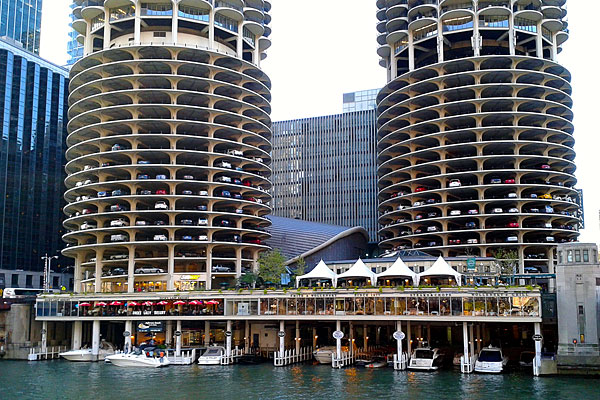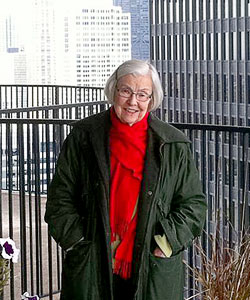
In July 1962, Dr. Theresa Southgate had the then-eccentric idea that she ought to live within walking distance of her new job at JAMA: The Journal of the American Medical Association, headquartered at Dearborn and Grand. “It was an awful neighborhood then, [with] nowhere to live,” Southgate recalls. But there was one big apartment project under construction four blocks south of the office, so she signed a lease.

Five decades later, Southgate is still living there, in the now-iconic Marina City, which marks its 50th anniversary next week. One of a handful of people who have lived at Marina City since the start, Southgate didn’t actually move in until February 1963, when her floor was ready for occupancy. She started out renting a one-bedroom apartment, but bought a two-bedroom unit on a higher floor when the building went condo in 1977.
Last week, Dr. Southgate and I talked about her tenure at Marina City, which was designed by Bertrand Goldberg. Here’s some of what she had to say:
• “At the management office on Randolph Street, Morrie Swibel [brother of the buildings’ developer Charles Swibel] asked what my budget was, and I said $180 a month. He said everything for that price would be on the 35th to 39th floors, and they were taken. I’d have to go on the 40th to 45th, and the rent would be $185. I said I couldn’t afford that and was going to leave, but he said, ‘Wait a minute, I can find something.’ He had a couple on 39 he could move up five floors because he didn’t think they would mind the extra [$5 a month].”
• Construction of the buildings was financed by several unions, including the Janitors Union. “I liked that idea because my father was a plumber, and I thought, in a high-rise, what you’re going to worry about is the water getting up to your faucets. We didn’t have residential high-rises in the city then. I thought, if the plumbers and janitors are behind this, it will be built right.”
• The concept of a self-contained community, with homes, restaurants, a bowling alley, and a movie theatre, also appealed. “There was nothing else down here then. There was nowhere to shop. When I wanted a loaf of bread I went to Marshall Field’s. They had a bakery in the basement. And there was a Stop and Shop at Randolph and State.”
• ”At first I couldn’t decide if I liked the look of Marina City. Was it wonderful or was it just outrageous? I never thought of these buildings looking like corncobs. To me it looks like a bunch of lacy concrete doilies or antimacassars my great aunts put on their furniture.”
• “I was truly intrigued by the circular floors. The bathroom and closets were in this little wedge, but from the rooms where you lived, your views were this magnificent expanse. I still like the circular floors. I go out every morning and walk around and around my floor. It’s my treadmill.”
“I know people are sad about [losing] Goldberg’s Prentice Hospital, but I think Marina City is the best of his buildings. He got the proportions right here—exactly the right circumference for the height of the tower.”
• Originally, each one-bedroom apartment was to share one of the buildings’ signature scalloped balconies with the apartment next door. To keep prying eyes from seeing into the bedrooms, the builders installed partitions, with a short length of chain extending from the partition to the balcony railing to block trespassing. “Those chains came to be called the Marina City chastity belts.”
• After her mother died, Southgate’s brother urged her to take over the family home in the suburbs. “He said, ‘I don’t understand why you want to live with all those people when you could be out there with green grass and flowers.’ I told him, ‘This is ideal. I walk to everything I want from here: the Art Institute, the symphony, the lake, and my job.’ Now that I’m older, I don’t do as much walking, but I love being here in the center of things. It’s home. I can’t imagine not living here.”
Photograph: (Marina City) Matthew Bisanz


